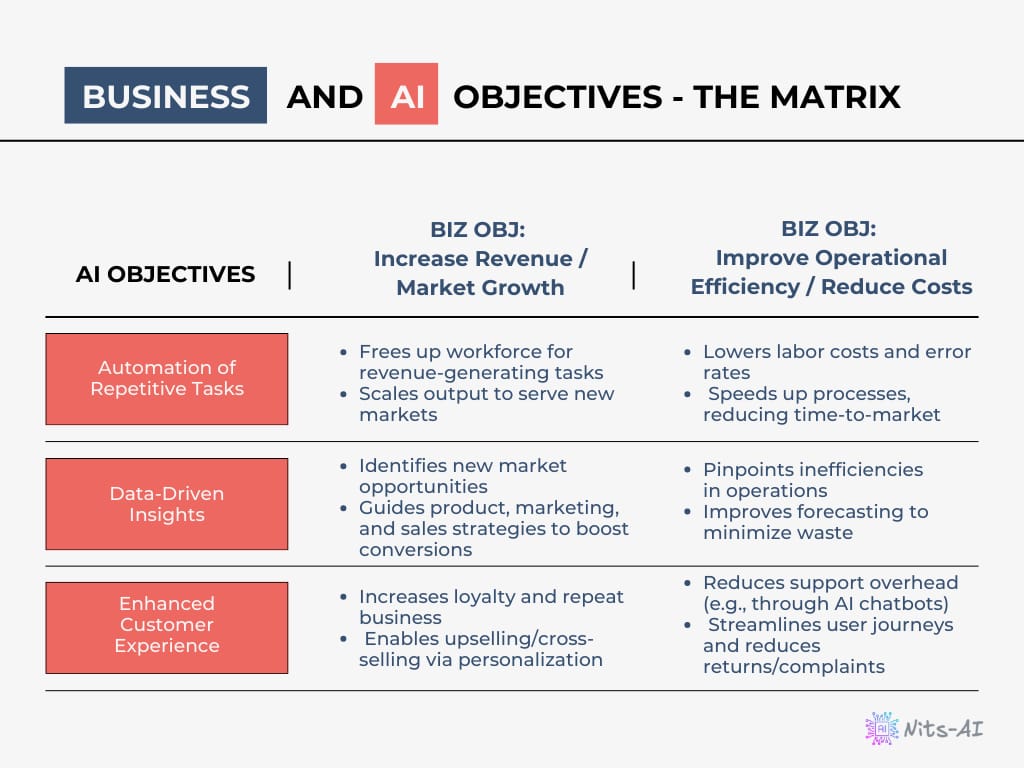- Nits-AI
- Posts
- AI Strategy: A Key Theme Gaining Traction Beyond Gen AI
AI Strategy: A Key Theme Gaining Traction Beyond Gen AI
Understanding what AI strategy is, key components and Objectives
An effective AI strategy isn't just about adopting technology—it's about aligning AI's capabilities with your business goals to create measurable value and lasting innovation."
Apart from “Gen AI” , one of the key themes gaining traction is AI Strategy.
In a business context, AI strategy refers to a deliberate plan for how an organization will harness artificial intelligence—such as machine learning, predictive analytics, and automation—to meet its objectives, improve efficiency, and create new growth opportunities.
This strategy typically aligns with and supports the business’s overall goals, whether that is to increase revenue, improve customer experience, streamline operations, or enter new markets.
AI strategy Components
Here are a few key components of a robust AI strategy:
Clear Objectives
Identify what specific business problems AI can help address.Examples could include automating repetitive tasks, analyzing large datasets for customer insights, or optimizing supply chain processes.
Data Management
AI algorithms depend on high-quality, well-organized data. Ensure consistent data collection, storage, and governance practices so you can use information effectively and ethically.
Skills and Talent
Develop or hire the technical expertise necessary to build, maintain, and refine AI solutions. Train existing teams on data literacy and AI adoption to foster a culture that embraces technology.
Technology Stack and Tools
Select platforms, frameworks, or cloud services that support your AI needs (e.g., machine learning libraries, data visualization tools). Consider scalability, security, and compliance when choosing your toolset.
Ethical and Responsible AI
Create guidelines and oversight that ensure AI solutions are transparent and do not inadvertently harm customers, employees, or the broader community. Address concerns such as data privacy, bias in algorithms, and explainability of AI decisions.
Implementation Roadmap
Start small with pilot projects to demonstrate value and build organizational buy-in. Scale up once you have proven success and refined best practices.
Continuous Monitoring and Optimization
Regularly measure the performance of AI initiatives against predetermined KPIs. Tweak data pipelines, models, and deployment methods to maintain or improve results.
Obviously, the first key component of an AI strategy is to have clear objectives and align the business goals and the AI benefits.
What are business Goals/ Objectives and some AI benefits?
Business Objectives
In terms of objectives , every business has two major objectives which are
Increase Revenue (e.g., through market growth or product enhancement)
Reduce Costs (e.g., by improving operational efficiency)
AI Benefits
Using AI can have 3 major beneficial objectives
Automation of Repetitive Tasks
Data-Driven Insights
Enhanced Customer Experience
1. Automation of Repetitive Tasks
What it is:
Using AI-driven tools (like robotic process automation or machine learning models) to handle routine, rules-based, or labor-intensive tasks automatically.
Why it matters:
Efficiency: Speeds up workflows and frees employees from mundane work.
Cost Savings: Reduces labor costs and error rates by minimizing manual intervention.
Scalability: Lets organizations handle growing workloads without significantly increasing headcount.
2. Data-Driven Insights
What it is:
Leveraging AI and analytics to extract actionable insights from large volumes of data—ranging from customer behavior patterns to operational metrics.
Why it matters:
Better Decision-Making: Informs strategic choices with evidence-based analysis rather than guesswork.
Market & Customer Understanding: Identifies trends, forecasts demand, and pinpoints new opportunities.
Continuous Improvement: Enables ongoing optimization of products, services, and internal processes.
3. Enhanced Customer Experience
What it is:
Implementing AI solutions (like personalized recommendations or chatbots) to deliver more engaging, relevant, and responsive interactions with customers.
Why it matters:
Personalization: Tailors content or product offers to individual preferences, improving satisfaction and loyalty.
Availability & Speed: Provides immediate, 24/7 assistance through automated chat or self-service tools.
Efficiency Gains: Minimizes wait times and support costs by handling common questions and tasks automatically.
Matching AI Objectives to Business Objectives
As a business, one needs to match the Business objective and the AI benefits . Below is a matrixes of the AI objectives and the Business objectives

Putting It All Together
Automation of repetitive tasks helps businesses operate more efficiently and cut costs.
Data-driven insights reveal new opportunities for revenue growth, competitive advantage, and operational optimization.
Enhanced customer experience increases satisfaction, loyalty, and ultimately can boost sales.
By focusing on these three AI objectives, an organization can align technology initiatives with broader strategic goals—whether that’s increasing market share, reducing operating expenses, or creating standout customer experiences.
Reply